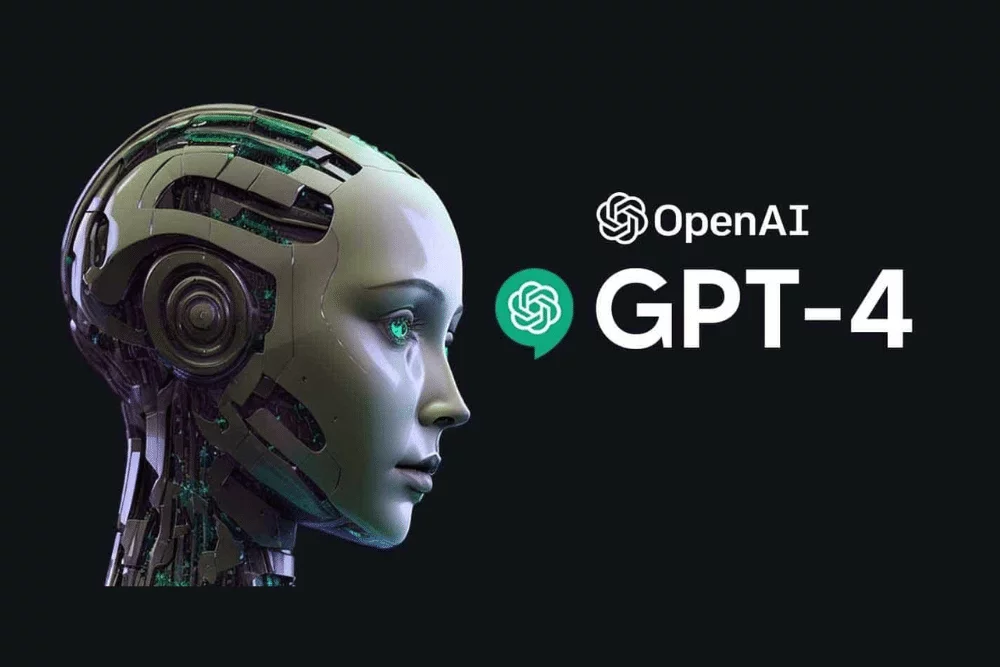India’s space agency, the Indian Space Research Organisation (ISRO), has achieved yet another milestone in its journey of space exploration. On August 23, 2023, the ISRO Chandrayaan-3 mission achieved a momentous success with a soft landing on the lunar surface. This historic achievement not only marks a significant advancement in India’s space capabilities but also reinforces its position as a prominent player in the global space arena. Let’s delve into the incredible journey of the LVM3-M4-Chandrayaan-3 mission, from its inception to the triumphant soft landing on the moon.

#ISRO CHANDRAYAAN
Mission Timeline and Achievements:
| Date | Event | Orbit Details |
|---|---|---|
| July 06, 2023 | Vehicle electrical tests completed | – |
| July 07, 2023 | Successful conclusion of Launch Rehearsal | – |
| July 11, 2023 | LVM3 M4 vehicle successfully launched | – |
| July 14, 2023 | Chandrayaan-3 in precise orbit, journey begins | – |
| July 15, 2023 | First orbit-raising maneuver | 41762 km x 173 km |
| July 17, 2023 | Second orbit-raising maneuver | 41603 km x 226 km |
| July 22, 2023 | Fourth orbit-raising maneuver | 71351 km x 233 km |
| July 25, 2023 | Orbit-raising maneuver | – |
| August 01, 2023 | Translunar Injection | 288 km x 369328 km |
| August 05, 2023 | Chandrayaan-3 inserted into lunar orbit | 164 km x 18074 km |
| August 06, 2023 | Lunar bound orbit | 174 km x 1437 km |
| August 09, 2023 | Chandrayaan-3’s orbit reduced | 151 km x 179 km |
| August 14, 2023 | Mission in orbit circularization phase | 153 km x 163 km |
| August 16, 2023 | Lander Module separated from Propulsion Module | – |
| August 17, 2023 | Second de-boosting maneuver | 113 km x 157 km |
| August 19, 2023 | Final de-boosting maneuver | 25 km x 134 km |
| August 20, 2023 | Powered descent commencement | – |
| August 23, 2023 | LIVE telecast of Soft-landing | – |
| August 23, 2023 | Successful soft-landing on the moon | – |
| August 01, 2023 | ‘I reached my destination and you too!’: Chandrayaan-3 | – |
| July 11, 2023 | Launch Rehearsal concluded | – |
| July 06, 2023 | Vehicle electrical tests completed | – |
| July 14, 2023 | Launch scheduled for July 14, 2023 | – |
Chandrayaan-3, the successor to the groundbreaking Chandrayaan-2 mission, is poised to demonstrate India’s advanced capabilities in safe lunar landing and surface roving. This mission encompasses a Lander and Rover configuration, poised to pave the way for lunar exploration prowess. Launched by the formidable LVM3 from SDSC SHAR, Sriharikota, Chandrayaan-3 takes us closer to unraveling the mysteries of the moon’s surface.
Mission Overview: LVM3-M4-Chandrayaan-3 Journey
Chandrayaan-3 is designed to exhibit a complete lunar exploration sequence, featuring a Lander Module (LM) and a Rover. The Propulsion Module (PM) supports the LM and Rover till a lunar orbit of approximately 100 km. In addition to its core mission, the PM carries the Spectro-polarimetry of Habitable Planet Earth (SHAPE) payload, aimed at analyzing Earth from the unique vantage point of the moon’s orbit.
Exploring Lunar Terrain: Lander and Rover Payloads
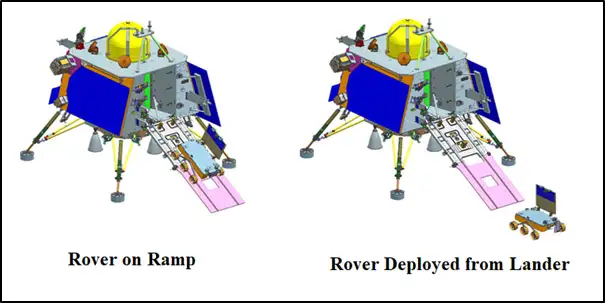
Lander Payloads:
- Chandra’s Surface Thermophysical Experiment (ChaSTE): This payload is tasked with studying the thermal conductivity and temperature on the lunar surface. ChaSTE aids in understanding the moon’s thermal behavior.
- Instrument for Lunar Seismic Activity (ILSA): ILSA is designed to measure seismic activity around the landing site, providing insights into the moon’s geological dynamics.
- Langmuir Probe (LP): LP estimates plasma density variations, enhancing our understanding of lunar ionosphere and atmospheric conditions. The payload offers valuable scientific data.
- Laser Retroreflector Array (LRA): A passive experiment from NASA, LRA contributes to lunar laser ranging studies, facilitating precise measurements.
Rover Payloads:
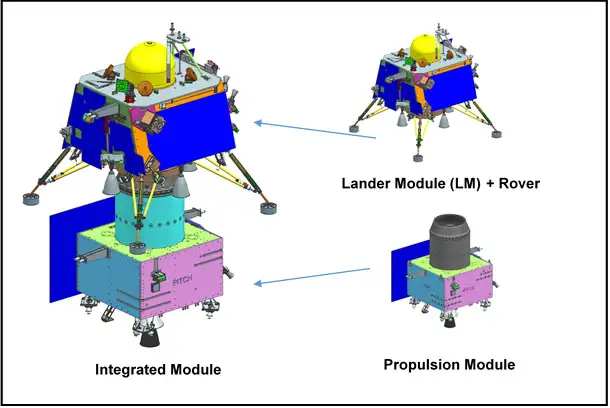
- Alpha Particle X-ray Spectrometer (APXS): APXS aims to determine the elemental composition of lunar soil and rocks near the landing site. It provides crucial insights into the moon’s chemical makeup.
- Laser Induced Breakdown Spectroscope (LIBS): LIBS plays a vital role in analyzing the elemental composition of the moon’s vicinity. It contributes to our understanding of lunar surface characteristics.
Chandrayaan-3’s Trajectory and Objectives
Chandrayaan-3 is propelled by an indigenous LVM3 M4 vehicle, placing the integrated module in an elliptic parking orbit of approximately 170 km x 36500 km. The mission is driven by three core objectives:
- Safe and Soft Landing on Lunar Surface: Demonstrating advanced technologies for a secure landing is a pivotal objective of Chandrayaan-3. It employs advanced altimeters, velocimeters, and inertial measurement systems to achieve this.
- Rover Roving on the Moon: The mission aims to showcase the Rover’s mobility on the lunar surface. The rover’s scientific instruments, including APXS and LIBS, gather data as it roves, aiding in comprehensive lunar exploration.
- In-situ Scientific Experiments: Chandrayaan-3 carries scientific payloads that conduct experiments directly on the lunar surface. This includes ChaSTE, ILSA, and LP, contributing to our understanding of the moon’s environment.
Advanced Technologies on Display
The Lander Module houses a multitude of advanced technologies that ensure its success under lunar conditions:
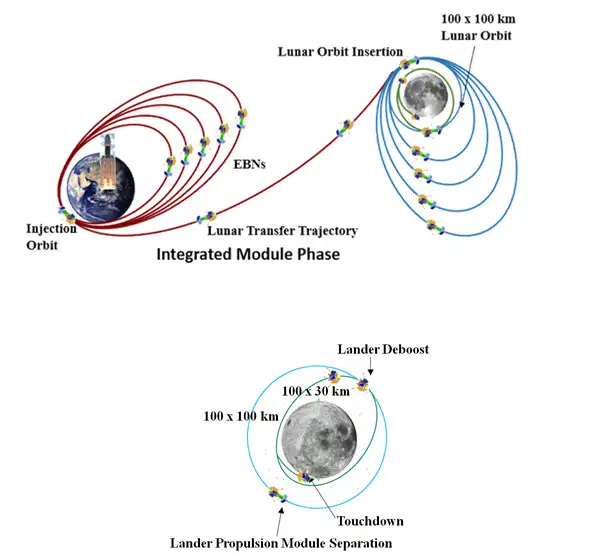
- Laser and Radio Frequency-based Altimeters enable precise altitude measurements.
- Laser Doppler Velocimeter and Lander Horizontal Velocity Camera facilitate velocity assessments.
- Laser Gyro-based Inertial referencing and Accelerometer package ensure accurate navigation.
- 800N Throttleable Liquid Engines, attitude thrusters, and Throttleable Engine Control Electronics govern propulsion.
Mission Progress: Tests and Achievements
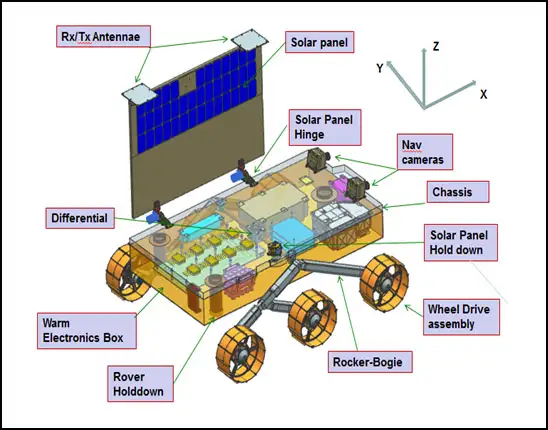
Chandrayaan-3’s journey is marked by a series of rigorous tests to ensure its readiness for the moon:
- Integrated Cold and Hot Tests validated sensor and navigation performance.
- Lander Leg mechanism performance was tested on a lunar simulant bed, simulating various touch-down conditions.
Conclusion
Chandrayaan-3 is a testament to India’s pursuit of excellence in space exploration. With a meticulously designed trajectory, advanced technologies, and a suite of scientific payloads, this mission underscores India’s ambition to unravel the mysteries of the moon. Chandrayaan-3 symbolizes the nation’s unwavering commitment to scientific progress and exploration, setting the stage for more remarkable space endeavors in the future. Stay tuned as Chandrayaan-3 embarks on its lunar odyssey, rewriting the narrative of lunar exploration.

